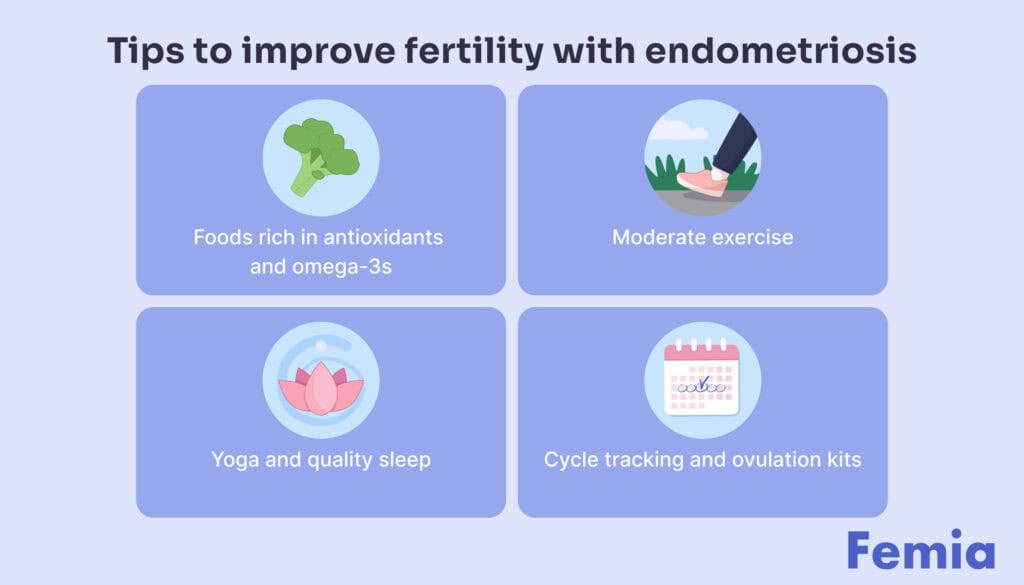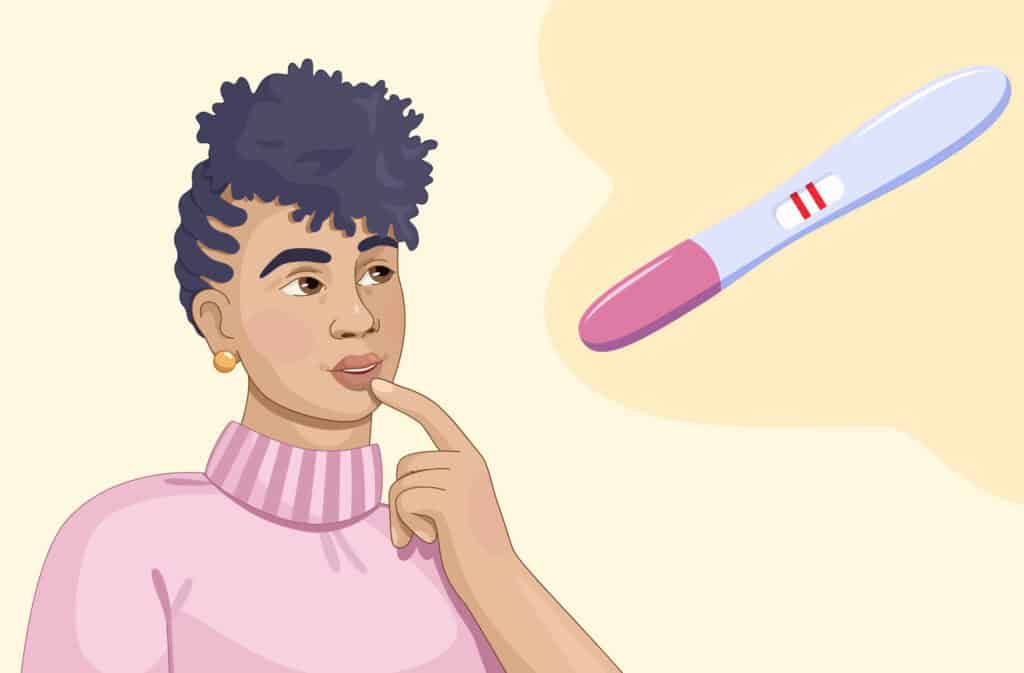Femia > Health Library > Getting Pregnant > Challenges > How to get pregnant with endometriosis naturally: Tips and strategies
How to get pregnant with endometriosis naturally: Tips and strategies

- Updated Feb 11, 2025
- Published
CRAFTED BY HUMAN
Crafted by human At Femia, we provide accurate and up-to-date information at every stage of your journey, from trying to conceive, pregnancy and postnatal support. All content is created by a real person based on in-depth research and own professional experience. Femia ensures that you will receive expert advice, strict accuracy and a personalized approach from our authors/medical experts. Learn more about our editorial policy.
FACT CHECKED
Fact checked At Femia Health, we maintain the highest standards of editorial excellence in delivering content focused on helping you conceive, guiding you through pregnancy, and supporting you postpartum. Explore our content review principles to learn how we ensure the accuracy and quality of our health and lifestyle tips for every stage of your journey.

Created with Hector Chapa, MD, FACOG, Clinical associate professor, Obstetrics and Gynecology Texas A&M University, College of Medicine in Bryan-College Station, USA
How to get pregnant with endometriosis? It’s still possible naturally when having regular sex. You can boost your chances of getting pregnant with endometriosis by eating healthy, staying active, managing stress, and tracking ovulation. After surgery, give your body time to heal and talk to your doctor to find the best plan for you.
If you have been recently diagnosed with endometriosis and doctors predict there might be some challenges with getting pregnant, you are not alone. According to the World Health Organization (WHO), endometriosis affects 10% (190 million) of both girls and women of reproductive age globally.
Even though the National Library of Medicine reports that 30-50% of women with endometriosis may experience infertility, there are tips for getting pregnant with endometriosis and answers about endometriosis and fertility.
What is endometriosis, and how does it affect fertility?
Endometriosis is a medical condition in which tissue similar to the lining inside the uterus (called the endometrium) starts to grow outside the uterus. This abnormal growth can occur on the ovaries, fallopian tubes, the outer surface of the uterus, and other organs in the pelvis and abdomen. The displaced tissue still responds to hormonal changes in the menstrual cycle, thickening, breaking down, and bleeding with each cycle. However, since there is no way for the blood to exit the body, it can lead to inflammation, scar tissue, and adhesions.
So, can you get pregnant with endometriosis? Endometriosis can have significant effects on fertility, making it more difficult for women to conceive:
- Fallopian tube blockage: Endometrial tissue can cause blockages, preventing eggs from reaching the uterus.
- Ovarian cysts: Endometriomas can impair egg release, reducing fertilization chances.
- Pelvic inflammation: Inflammation and scarring affect ovarian and tube function.
- Adhesions: Scar tissue can hinder egg or sperm movement, reducing fertilization chances.
- Hormonal disruption: Endometriosis can prevent regular ovulation and affect hormone levels.
- Implantation issues: Inflammation can interfere with embryo implantation.
Femia offers the most accurate tool for determining ovulation and fertile days
Symptoms of endometriosis
Endometriosis is often hard to diagnose, since symptoms vary. Some women may not notice it at all, while others may have severe pain. However, there are some key symptoms that doctors look for to diagnose endometriosis:
- Painful, heavy, or irregular periods;
- Pain in the lower abdomen, pelvis, or lower back, which may be worse around ovulation time;
- Pelvic pain that lasts over 6 months;
- Pain during or after sex;
- Pain when urinating (weeing) or pooping;
- Difficulty getting pregnant.
👉Find out more: Endometriosis self-care: tips for managing symptoms and boosting fertility
While each of these symptoms independently may signal many other health conditions, two or more symptoms from the list above often indicates endometriosis.
The exact reason why endometriosis affects fertility is unclear, though healthcare professionals agree that it may be more difficult to conceive if endometriosis is severe.
Can you have kids with endometriosis? According to NCBI, women diagnosed with mild endometriosis have a lower probability of pregnancy over 3 years compared to women with unexplained infertility (36% vs. 55%, respectively). Further IVF studies found that women with more severe symptoms have poor ovarian reserve and low oocyte and embryo quality, which makes it harder for them to conceive.
👉Find out more: If you ovulate in the morning can you get pregnant that night
What are the chances of getting pregnant with endometriosis?
Endometriosis does not always mean infertility, and natural conception is possible in any case of severity.
According to a 2014 review, women with endometriosis regularly having sex have a 2–10% chance of conceiving each month. The same source reports that those who don’t have the disease have 15–20% chance.
What is the best age to get pregnant with endometriosis?
The best age to get pregnant with endometriosis is typically in your 20s to early 30s when fertility is at its peak. Endometriosis can reduce fertility, and the condition tends to worsen with age, making it more difficult to conceive as you get older.
However, many women with endometriosis are still able to conceive naturally with appropriate treatment. If you’re struggling to get pregnant, consulting a fertility specialist is recommended to explore options like surgery or assisted reproductive technologies (ART), which can improve your chances of conception.
How to improve your chances of pregnancy with endometriosis?
There are many simple strategies recommended to help manage the symptoms and severity of endometriosis, and following these tips may increase your chances of conceiving.
Diet and lifestyle changes to support fertility
- Consider diet changes: Even though diet alone won’t cure endometriosis, some changes may help manage symptoms and assist in getting pregnant. Food significantly affects hormone levels, weight, and inflammation—all factors which may negatively affect the severity of the disease. Try to include foods rich in antioxidants and omega-3 fatty acids, like fruits, vegetables, seeds, nuts, and fatty fish.
👉 Find out more: Enhancing fertility naturally: A guide to fertility supplements and foods for women
- Engage in moderate physical activity: An NCBI study reported that regular physical activity can be a helpful measure in reducing endometriosis-related pain and inflammation. The reason is that our bodies release myokines—a group of cytokines including IL-6, irisin, and myostatin—when our muscles are working. These myokines contribute to anti-inflammatory, metabolic, and immunological processes. While regular walks are sufficient for managing the disease’s symptoms, exercises like swimming, walking, and biking may help reduce estrogen levels, stress, and inflammation.
Managing stress levels
According to the National Institutes of Health (NIH), endometriosis is associated with high levels of chronic stress, which correlates with pain severity and disease extension.
Regular yoga practices (2-3 times a week), moderate physical activity to your liking, quality sleep (at least 8 hours a night), and spending more time in nature are highly effective strategies for managing stress levels and reducing pain.
Track your menstrual cycle
Monitoring your menstrual cycle greatly helps determine the best days for conception. You can consider using ovulation prediction kits, tracking basal body temperature, or tracking apps to identify your fertility window.
It is also recommended to have sex every two to three days throughout the entire cycle. But, it is mostly important when you are most likely to ovulate.
Surgical options to improve fertility
Surgery is often recommended for women with endometriosis who are struggling to conceive. The goal is to remove as much endometrial tissue as possible while preserving ovarian function and fertility. The two main types of surgery are:
- Laparoscopy: This minimally invasive surgery involves removing or destroying the endometriosis tissue. It can improve fertility by relieving symptoms and reducing the severity of the condition.
- Laparotomy: A more invasive surgery used for severe cases, which may involve removing large endometriosis implants or cysts. This type of surgery is less common but may be necessary in extreme cases.
Both types of surgery can improve the chances of conception, especially when combined with other fertility treatments.
Reproductive techniques (IUI, IVF)
For women with endometriosis who continue to have difficulty conceiving after surgery, assisted reproductive technologies (ART) can help:
Intrauterine insemination (IUI): This procedure involves placing sperm directly into the uterus around the time of ovulation, increasing the chances of sperm meeting the egg. IUI is often recommended when endometriosis affects the fallopian tubes or ovulation.
In vitro fertilization (IVF): IVF may be recommended for women with more severe endometriosis, especially if there is damage to the fallopian tubes or severe scarring. IVF involves fertilizing the egg outside the body and then implanting the embryo into the uterus.
Both IUI and IVF can be effective in overcoming fertility challenges related to endometriosis, although success rates may vary depending on the severity of the condition.

What are peak fertility times?
Ovulation means a mature egg is released from the ovary and moves down the fallopian tube, where it can later be fertilized. If sperm is in the fallopian tube at that time, the chances of getting pregnant are higher compared to any other day of the cycle.
The most fertile days (also called a fertility window) are the three days leading up to and including ovulation. To identify the length of the menstrual cycle and fertility window, record the first day you start bleeding—this is counted as the 1st day of your cycle. The last day of the cycle is the day before the next period.
Ovulation usually happens about 14 days before starting your period.
- If your menstrual cycle is 25-28 days, you ovulate around days 12-14. Your fertility days are 10, 11, 12, 13, and 14, respectively.
- In the case of a shorter cycle, let’s say 19-21 days, ovulation will happen approximately on day 7, and your most fertile days will be 3, 4, 5, 6, and 7, respectively.
Those having irregular cycles may find it harder to identify fertility days, so tracking with apps and checking symptoms will always be a good idea. Some women experience breast pain, abdominal pain, and mood swings before and during ovulation, so this might be helpful in determining the fertility window with irregular cycles.
👉Find out more: How to boost fertility in your 30s
Will surgery or having a laparoscopy increase your chances of falling pregnant?
The role of surgery in increasing the chances of conceiving in women with endometriosis is much debated. According to a 2013 study performed by NCBI, which compares laparoscopic surgical treatment of minimal and mild endometriosis with diagnostic laparoscopy only, laparoscopic surgery enhanced fertility rates, but the second group found no positive effect of surgery.
Another study reported that 63 of 87 participants diagnosed with endometriosis (72.41%) were able to fall pregnant. The same study also indicated that there wasn’t a significant difference between the groups half a year, one year, or two years after the surgery.
For women with superficial endometriosis, where the tissue attaches to the peritoneum, laparoscopic surgery may improve chances of conception. Ithas been shown to have positive effects on both pregnancy rates and chances of conceiving naturally. However, there has been little research on its effect on pregnancy rates in women with deep endometriosis (where the bowel, bladder, or ureter are involved).
Please note that consulting a healthcare professional is still a must when choosing the next steps of your pregnancy journey.
👉Find out more: Best age to get pregnant with PCOS
Femia offers the most accurate tool for determining ovulation and fertile days
When to try getting pregnant after endometriosis surgery
As mentioned above, in the case of laparoscopic surgery, there were no changes between the groups at half a year, 1 year, or 2 years after the procedure. And, while age still plays a crucial factor in the chances of getting pregnant, there is no need to rush after surgery. When you can start trying to get pregnant after endometriosis surgery will depend on the specifics of your situation.
Let’s break down two different cases:
Case 1: If there was no work with the ovaries or the removal of fibroids from the uterine wall, you may want to try for a baby the next cycle.
Case 2: If the surgery removed endometriomas or fibroids, doctors usually recommend waiting at least 3 months to allow the ovaries and uterus to fully heal before conception is attempted.
In any case, prioritize healing before trying to conceive, and please consult a healthcare professional to get customized guidance, since surgery may differentially affect all bodies.
Questions from the Femia community
Does endometriosis cause problems with pregnancy?
Endometriosis has been shown to make it harder to get pregnant. The exact reason is still unknown, but managing symptoms and consulting a doctor can help you increase the chances of getting pregnant naturally.
Does endometriosis increase the likelihood of having a miscarriage?
Some studies report that, depending on the severity of the disease and symptoms, endometriosis might increase the risk of pregnancy complications, with miscarriage as a worst-case scenario. That is because endometriosis might also impact the hormones required for the embryo to develop.
Will I still experience endometriosis pain while I am pregnant?
Since symptoms vary and more studies are needed to clarify the exact link between endometriosis and pregnancy, there is no exact answer for everyone. Some women with endometriosis may still experience some symptoms, while others may even see their symptoms worsen during the early months of pregnancy. This usually happens because the uterus expands to accommodate the growing fetus.
What about breastfeeding?
Even though doctor consultation is always required, breastfeeding is allowed for women with endometriosis. In fact, the hormonal changes your body releases during breastfeeding may help reduce pain and disease recurrence.
The bottom line
Endometriosis affects up to 10% of women between 15 and 44. In some cases, the disease doesn’t have any symptoms and is only discovered when women try to get pregnant. In other cases, symptoms can be pretty rough.
Irrespective of symptoms and severity of the disease, the chances of getting pregnant with endometriosis when having regular sex are still pretty high, and there are many ways you can improve the odds. Working closely with your healthcare provider to find the best approach to your case, as well as making lifestyle changes, can help you manage endometriosis symptoms and increase your chances of conception.
References
- WHO. “Endometriosis.” World Health Organization, World Health Organization, 24 Mar. 2023, www.who.int/news-room/fact-sheets/detail/endometriosis.
- Petrozza, John. “Endometriosis and Its Impact on Fertility.” Massachusetts General Hospital, 26 Jan. 2023, www.massgeneral.org/obgyn/fertility/news/endometriosis-and-its-impact-on-fertility#:~:text=Endometriosis%20can%20make%20it%20more.
- Macer, Matthew Latham, and Hugh S. Taylor. “Endometriosis and Infertility.” Obstetrics and Gynecology Clinics of North America, vol. 39, no. 4, Dec. 2012, pp. 535–549, https://doi.org/10.1016/j.ogc.2012.10.002.
- Macer, Matthew Latham, and Hugh S. Taylor. “Endometriosis and Infertility.” Obstetrics and Gynecology Clinics of North America, vol. 39, no. 4, Dec. 2012, pp. 535–549, https://doi.org/10.1016/j.ogc.2012.10.002.
- Fadhlaoui, Anis, et al. “Endometriosis and Infertility: How and When to Treat?” Frontiers in Surgery, vol. 1, 2 July 2014, www.ncbi.nlm.nih.gov/pmc/articles/PMC4286960/, https://doi.org/10.3389/fsurg.2014.00024.
- Barnard, Neal D., et al. “Nutrition in the Prevention and Treatment of Endometriosis: A Review.” Frontiers in Nutrition, vol. 10, 17 Feb. 2023, https://doi.org/10.3389/fnut.2023.1089891.
- Kahr, Maike, et al. “Physical Activity in Women with Endometriosis: Less or More Compared with a Healthy Control?” International Journal of Environmental Research and Public Health, vol. 20, no. 17, 26 Aug. 2023, pp. 6659–6659, https://doi.org/10.3390/ijerph20176659. Accessed 22 Sept. 2023.
- Kahr, Maike, et al. “Physical Activity in Women with Endometriosis: Less or More Compared with a Healthy Control?” International Journal of Environmental Research and Public Health, vol. 20, no. 17, 26 Aug. 2023, pp. 6659–6659, https://doi.org/10.3390/ijerph20176659. Accessed 22 Sept. 2023.
- Reis, Fernando M., et al. “Is Stress a Cause or a Consequence of Endometriosis?” Reproductive Sciences, vol. 27, no. 1, Jan. 2020, pp. 39–45, https://doi.org/10.1007/s43032-019-00053-0.
- Ravins, Inbal, et al. “The Effect of Practicing “Endometriosis Yoga” on Stress and Quality of Life for Women with Endometriosis: AB Design Pilot Study.” Alternative Therapies in Health and Medicine, vol. 29, no. 3, 1 Apr. 2023, pp. 8–14, pubmed.ncbi.nlm.nih.gov/35839113/.
- Coccia, Maria Elisabetta, et al. “Endometriosis and Infertility: A Long-Life Approach to Preserve Reproductive Integrity.” International Journal of Environmental Research and Public Health, vol. 19, no. 10, 19 May 2022, p. 6162, https://doi.org/10.3390/ijerph19106162.
- Lee, Hye Jun, et al. “Natural Conception Rate Following Laparoscopic Surgery in Infertile Women with Endometriosis.” Clinical and Experimental Reproductive Medicine, vol. 40, no. 1, 1 Mar. 2013, pp. 29–32, www.ncbi.nlm.nih.gov/pmc/articles/PMC3630290/#:~:text=after%20the%20laparoscopy.-, https://doi.org/10.5653/cerm.2013.40.1.29.
- Zhang, Liyi, et al. “Pregnancy Outcomes in Patients with Tubal Infertility Following Laparoscopic Treatment: A Multivariate Predictive Study.” Annals of Palliative Medicine, vol. 10, no. 1, Jan. 2021, pp. 462–462, https://doi.org/10.21037/apm-20-2347. Accessed 11 Aug. 2022.

Explore getting pregnant at 40 and learn everything about fertility treatments and pregnancy at 40. Discover expert tips to optimize fertility and navigate age-related challenges.

How do you distinguish between discharge before period vs early pregnancy? Click here for a comprehensive guide that will help you understand the difference.

Discover the top fertility-boosting foods and a 7-day fertility diet meal plan to increase your chances of conceiving. Learn what to eat and avoid when trying to get
